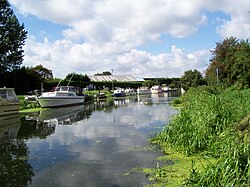| River Ancholme | |
|---|---|
 The old River Ancholme in Brigg | |
| Physical characteristics | |
| Source | |
| • location | Bishopbridge, Lincolnshire |
| Mouth | |
• location | South Ferriby, Lincolnshire (The Humber, North Sea) |
| Length | 17 mi (27 km) (navigable) |
The River Ancholme is a river in Lincolnshire, England, and a tributary of the Humber. It rises at Ancholme Head, a spring just north of the village of Ingham[1] and immediately west of the Roman Road, Ermine Street. It flows east and then north to Bishopbridge west of Market Rasen,[2] where it is joined by the Rase. North of there it flows through the market town of Brigg before draining into the Humber at South Ferriby. It drains a large part of northern Lincolnshire between the Trent and the North Sea.
The river has been used by humans since at least 800 BC, seen by the excavation of a planked boat at Brigg. Letters patent for improvements to the river are known from 1287 onwards. Major change occurred in 1635, when a new straight channel was constructed from Bishopbridge to Ferriby. The new channel carries most of the water, the New River Ancholme, whereas the Old River Ancholme still meanders. The latter is mostly reduced to a ditch, save around Brigg's central 'Island Carr'. Further improvements were started by John Rennie (the Elder) in the early 1800s and completed by his son in the 1820s, with the reconstruction of Ferriby Sluice taking place around 1841.
From that time onwards the river was reasonably profitable. Receipts fell when railways arrived locally but trade picked up in the 1890s, and was boosted by cargoes of sugar beet in the 1930s. All commercial carrying ceased: above Brigg by the 1970s; altogether as of the 1980s. Upper reaches were in places part-blocked so were restored and dredged in 2004. The river is used for leisure, with boating, rowing, canoeing and fishing taking place. Responsibility or merely the name of the body for the river changed six times between 1930 and 1996, ending with the Environment Agency.
The Ancholme Internal Drainage Board maintains twelve pumping stations which can pump water from the surrounding low-lying land to prevent flooding. The river is used by Scunthorpe Steelworks, and Anglian Water supplying the South Humber bank industrial area. To meet these needs in many dry times water is transferred from Barlings Eau, near the Witham, by the Trent-Witham-Ancholme transfer scheme, commissioned in 1974.
Some bridges are private rights of way – remaining such as conscious of the risk of driver shortcutting and over-use – many such are listed (statutorily protected for architectural merit or age). Similarly, Ferriby Lock is a scheduled ancient monument. Local moorings host two historic boats owned by the Humber Keel & Sloop Preservation Society.
River Ancholme | |||||||||||||||||||||||||||||||||||||||||||||||||||||||||||||||||||||||||||||||||||||||||||||||||||||||||||||||||||||||||||||||||||||||||||||||||||||||||||||||||||||||||||||||||||||||||||||||||||||||||||||||||||||||||||||||||||||||||||||||||||||||||||||||||||||||||||||||||||||||||||||||||||||||||||||||||||||||||||||||||||||||||||||||||||||||
|---|---|---|---|---|---|---|---|---|---|---|---|---|---|---|---|---|---|---|---|---|---|---|---|---|---|---|---|---|---|---|---|---|---|---|---|---|---|---|---|---|---|---|---|---|---|---|---|---|---|---|---|---|---|---|---|---|---|---|---|---|---|---|---|---|---|---|---|---|---|---|---|---|---|---|---|---|---|---|---|---|---|---|---|---|---|---|---|---|---|---|---|---|---|---|---|---|---|---|---|---|---|---|---|---|---|---|---|---|---|---|---|---|---|---|---|---|---|---|---|---|---|---|---|---|---|---|---|---|---|---|---|---|---|---|---|---|---|---|---|---|---|---|---|---|---|---|---|---|---|---|---|---|---|---|---|---|---|---|---|---|---|---|---|---|---|---|---|---|---|---|---|---|---|---|---|---|---|---|---|---|---|---|---|---|---|---|---|---|---|---|---|---|---|---|---|---|---|---|---|---|---|---|---|---|---|---|---|---|---|---|---|---|---|---|---|---|---|---|---|---|---|---|---|---|---|---|---|---|---|---|---|---|---|---|---|---|---|---|---|---|---|---|---|---|---|---|---|---|---|---|---|---|---|---|---|---|---|---|---|---|---|---|---|---|---|---|---|---|---|---|---|---|---|---|---|---|---|---|---|---|---|---|---|---|---|---|---|---|---|---|---|---|---|---|---|---|---|---|---|---|---|---|---|---|---|---|---|---|---|---|---|---|---|---|---|---|---|---|---|---|---|---|---|---|---|---|---|---|---|---|---|---|---|---|---|---|---|---|---|---|---|---|---|
| |||||||||||||||||||||||||||||||||||||||||||||||||||||||||||||||||||||||||||||||||||||||||||||||||||||||||||||||||||||||||||||||||||||||||||||||||||||||||||||||||||||||||||||||||||||||||||||||||||||||||||||||||||||||||||||||||||||||||||||||||||||||||||||||||||||||||||||||||||||||||||||||||||||||||||||||||||||||||||||||||||||||||||||||||||||||
